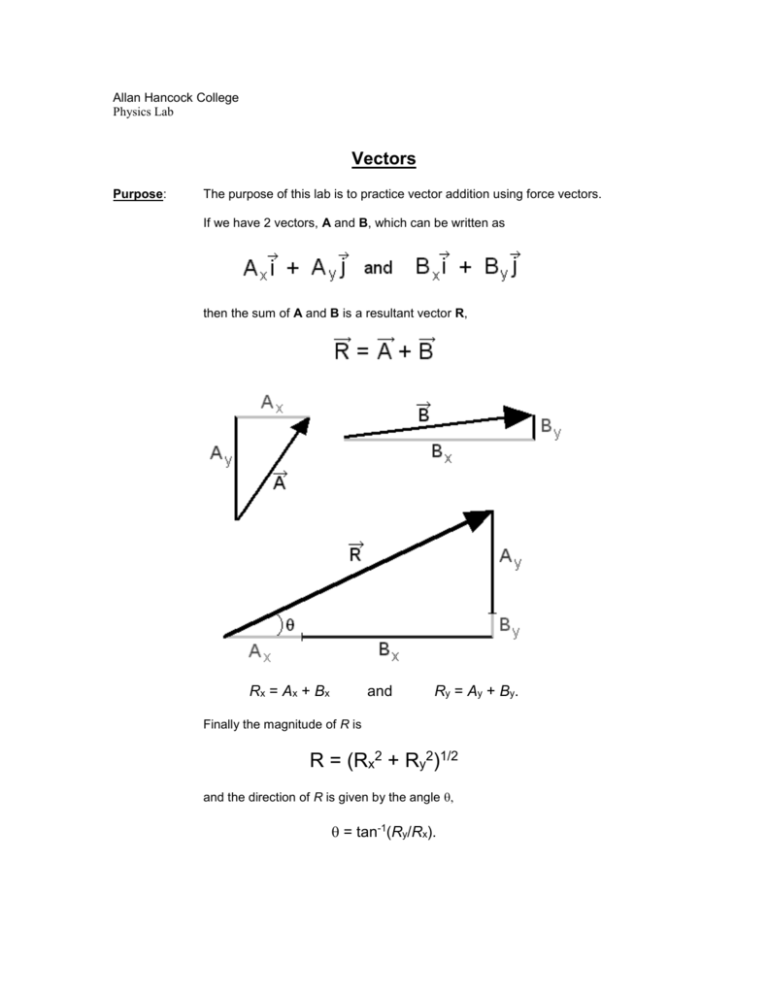Vectors
advertisement

Allan Hancock College Physics Lab Vectors Purpose: The purpose of this lab is to practice vector addition using force vectors. If we have 2 vectors, A and B, which can be written as then the sum of A and B is a resultant vector R, Rx = A x + B x and Ry = Ay + By. Finally the magnitude of R is R = (Rx2 + Ry2)1/2 and the direction of R is given by the angle = tan-1(Ry/Rx). Apparatus: Force table, weights, strings, graph paper, and protractor. Procedure: Exp. 1: Graphical representation of vector forces Using the force table with one pulley at 0o and another at 90o, apply two forces to center ring by hanging different masses over the pulleys. Find the magnitude of each weight force by using weight (w) = mg, Use g ~ 10 m/s 2. Use the force table to experimentally determine the magnitude and direction of the weight which will exactly balance the two applied forces. Draw a plot in your lab book, showing the two applied force vectors and the resultant vector needed to balance them. Be sure to represent each force by the length of your vector. What should the vector sum of these vectors be? Experiment 2: Adding 2 vectors to determine the resultant vector (net force) Using the force table with one pulley between 0 o and 90o, the other between 90 and 150, apply two forces to center ring by hanging different masses over the pulleys. Don’t use directions like 30, 45, 90, etc, challenge yourself with more interesting numbers. Find the magnitude of each weight force by using weight (w) = mg, Use g ~ 10 m/s 2. First, use the force table to graphically determine what your resultant vector would be. Use the head to tail and/or the parallelogram method to graphically draw the resultant vector (don’t do any calculations or experimentation, simply use a ruler and a protractor to graphically add the vectors together). Measure the length of the resultant vector and convert that to force and mass. Second, mathematically calculate the exact magnitude and direction of your resultant vector using methods of trigonometry (SOHCAHTOA). How close is your calculated result to your graphical result? Finally, experimentally determine the vector that balances the two applied forces. This vector should be the negative of the resultant vector (that means simply add or subtract 180 degrees). How close is your experimentally derived result to that of the graphical and calculated results. Experiment 3: Adding 3 vectors. Balance the ring experimentally with 3 force vectors. Graphically determine what the resultant of these three vectors should be, then experimentally determine the weight that exactly ballances them. Again, this should be the negative of the resultant. Do your graphical and experimental results match up? Repeat this with 4 force vectors (if time permits). CONCLUSIONS: Compare and contrast the three different methods of vector addition. Which is the most accurate? Which is the most visual? Which is the easiest to do? Be sure to include your numerical results in your conclusion for each of the three methods. This is best done using a table to display your final data and results. Be sure to include calculations of the difference between what you expected and what you got. Have fun…






